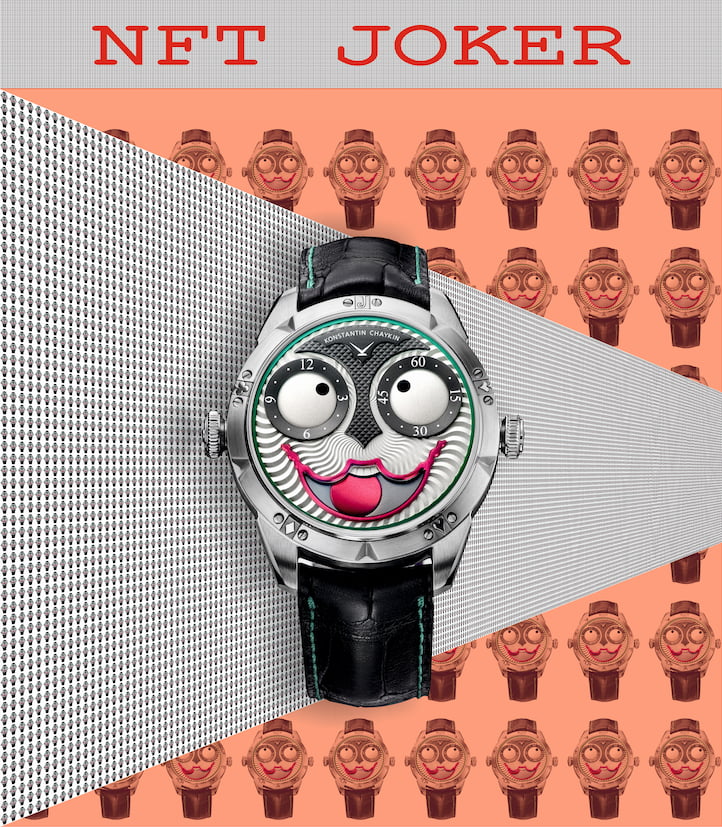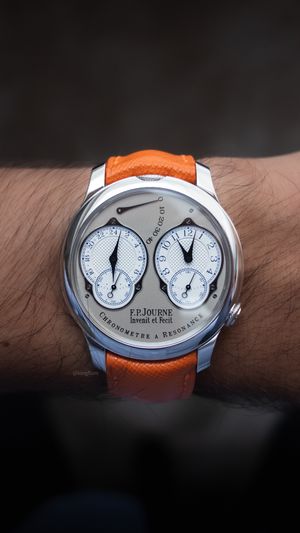
Credit: Yuga Labs
Watches and NFTs might seem like a pointless combination; after all, we enjoy wearing the watches we own, so what's the point of having a digital version? In this post, I conduct a few thought experiments and draw some analogies with the success of the famous Bored Ape Yacht Club, and then brainstorm how this success can be applied to our world of watches.
Intro
In his 2017 book The Four, Scott Galloway compared Apple with Facebook, Google and Amazon, and wrote that Apple stood “alone as a luxury brand”, implying that this differentiation provided it with defences unavailable to the other technology giants.
Sticking with luxury brands and what they might spend to attract customers... Chanel's Ginza Building in Tokyo, designed by world-famous architect Peter Marino, reportedly cost $240 million to build. Half of that budget was used to build a 215-foot-tall, 10-story façade containing 700,000 LEDs that projected the Chanel logo at night... making it the largest television screen in the world. In her book Deluxe: How Luxury Lost its Luster, Dana Thomas reported that the president of Chanel at that time told her they expected full-payback on the investment within 3 years. “A year and a half after it opened, there were still lines out front.”
 Chanel flagship store in Ginza, Tokyo, featuring a massive screen in its front facade.
Chanel flagship store in Ginza, Tokyo, featuring a massive screen in its front facade.
So... if you try and draw parallels with the metaverse - How does one recreate that 'Tokyo attraction' in the virtual world? Chanel spent this money because there is only one Tokyo... and the same applies to all the cosmopolitan capitals around the world. Advertising on the famous Piccadilly Circus screen is expensive because, well, its Piccadilly Circus! Compare that with land prices in the digital world, and things are anything but stable or predictable. The November 12, 2021 issue of Grant’s Interest Rate Observer states:
According to Janine Yorio, head of Republic Realm, a hedge fund that develops and invests in digital real estate, a set of 100 private islands that her business developed with a “real-world” architect fetched $15,000 each in August pre-sales. Today, on the secondary market, the islands trade for $300,000–$350,000 a pop.
Physical real estate is a finite resource... and so, in an 'infinite digital metaverse', how do we recreate scarcity and limited supply? Apple’s aforementioned association with luxury and the 'natural defense' this creates, was reinforced through internal documents from the legal battle with Epic Games Inc. What this revealed, was how Apple enforced early brand habits using their iMessage platform. According to the Wall Street Journal:
From the beginning, Apple got creative in its protection of iMessage’s exclusivity. It didn’t ban the exchange of traditional text messages with Android users but instead branded those messages with a different color; when an Android user is part of a group chat, the iPhone users see green bubbles rather than blue. It also withheld certain features. There is no dot-dot-dot icon to demonstrate that a non-iPhone user is typing, for example, and an iMessage heart or thumbs-up annotation has long conveyed to Android users as text instead of images.
Wall Street Journal
With the Apple brand likely seen as a status symbol, most teens (87% according to this study) choose an iPhone over every other device. The threat of rejection that accompanies a green text box is sufficient motivation, not only to own an iPhone, but to avoid other devices. This is just one of many examples of Apple’s broader ecosystem strategy, creating a self-reinforcing 'walled garden' of sorts. MKBHD has an entire video explaining it too.
Today, someone might purchase a Richard Mille watch or Birkin bag to communicate that they have wealth... but how does one communicate this in a virtual world without physical objects? Consider the Bored Ape Yacht Club (BAYC) as an example... minimum cost of entry is 71 ETH, or about $170,000 today (was over $200k a few weeks ago lol!) - owning one of these apes is an outright show of wealth. Brands are also gearing up to style individual avatars in the metaverse with NFTs. As an example, Nike recently purchased a virtual shoe company to make sneakers for the metaverse. I'd guess Apple will find additional creative solutions, similar to the blue text message bubble on an iPhone... and I'm sure you can come up with many other examples of your own - we will come back to the BAYC later.
So, what about NFTs and watches?
At $13.3 billion, NFT marketplace OpenSea is now considered the second most valuable crypto startup in the world. Dapper Labs, the startup behind NFT marketplace NBA Topshot, raised $250 million last year at a $7.6 billion valuation. Last week, Autograph, an NFT collections startup, announced that it raised $170 million in new venture capital funding co-led by Andreessen Horowitz and Kleiner Perkins. Aside from the value raised, the interesting part is that the company is co-founded by Tom Brady (the Tampa Bay Buccaneers quarterback, and former New England Patriots quarterback... Seven-time Super Bowl champion). Lots of celebrity-backed NFTs have traded at lower prices in secondary markets, and some celebrities seem to know how to make it work... Paris Hilton drops for example resold for a higher valuation.
Turns out, celebrities and the cryptocurrency world have a highly relevant relationship, which we will discuss in more detail. Earlier this month, Kim Kardashian and Floyd Mayweather were sued for allegedly promoting a token and artificially boosting its price. There is also a sense that celebrities are diving into a world that they don't fully understand, as the SEC said during the first crypto surge of 2017, "Celebrities who endorse an investment often do not have sufficient expertise to ensure that the investment is appropriate."
In the previous crypto bull run, the unique selling point was the potential to upend banks, and 'decentralise global finance'. Most of the current bull run is about the consumer, with whom celebrities have an immense amount of 'cultural equity' and are therefore able to influence them at will. What we're beginning to see more often, is investors looking to make the celebrity successes more common - and essentially betting that crypto could go 'more mainstream' with the help of the right star power. We will come back to this later.
Moving onto watches ... You may have already seen the Hodinkee interview with the watch guy making NFTs... this gentleman is selling 3D rendered watches which digitally replicate Rolex lookalikes, and he seems to be doing quite well. In my opinion he also appears to be devaluing his own NFTs by making free transfers of his art, thus hurting the market value for genuine (paying) collectors of his art.
 Credit: Jesus Calderon / Hodinkee
Credit: Jesus Calderon / Hodinkee
Jacob & Co. released the first-ever NFT watch, which fetched $100k at an auction on the Artgails NFT platform.
 The SF24 Tourbillion timepiece features a working split flap system which displays cryptocurrencies like Bitcoin, Ethereum, and XRP in a ten-second animation that appears on the watch’s face.
The SF24 Tourbillion timepiece features a working split flap system which displays cryptocurrencies like Bitcoin, Ethereum, and XRP in a ten-second animation that appears on the watch’s face.
Jean-Claude Biver and Switzerland's WISeKey International Holding Ltd, a Swiss cybersecurity company, also claim to have offered the “first NFT auction of a luxury watch” on NFT marketplace OpenSea.
 Hublot Bigger Bang All Black Tourbillon Chronograph "Special piece", reportedly Jean-Claude Biver's favourite watch (lol!)
Hublot Bigger Bang All Black Tourbillon Chronograph "Special piece", reportedly Jean-Claude Biver's favourite watch (lol!)
Konstantin Chaykin turned his renowned ‘Joker’ timepiece into an NFT and auctioned it for Ether at Ineichen Zurich on 22 May 2021. The unique piece is made up of 42,480 computerized images — one for each minute of the 59 days between March 13th and May 11th, 2021 when the new moon was in the Pisces constellation.
 This is how Konstantin Chaykin’s NFT-Joker was initially presented.
This is how Konstantin Chaykin’s NFT-Joker was initially presented.
Some interesting examples... but none of these watch NFTs seem to really matter, in my opinion. They seem like early attempts to get into the game, but with no clear purpose other than being first, or providing an option to those who are excited by NFTs.
Going back to BAYC, a mix of three things give these apes 'value'. Ownership by, or involvement of, celebrities / influencers, utility or access, and community strength. The celebrity endorsement angle is quite self-explanatory. When Jimmy Fallon bought an ape, he used it as his profile picture on Twitter, where he has 50 million followers... That directly caused a flurry of hype around BAYC, and led to noticeable sales value & volume spikes at the time. I'm sure you've seen people do this on Instagram too, trying to replicate this effect in a more minuscule way... FOMO is a dangerous thing!
In terms of utility, BAYC offers all ape owners exclusive access to certain games (with desirable prizes), and BAYC merchandise and clothing amongst other things. A lot of this stuff is extremely coveted, to the point where you can find BAYC merchandise resold for multiples of the original price... which, indirectly, brings further value to the ape-owners'. There are also other benefits which are more nuanced, and specific to the NFT world - for example, owning an ape grants access to a 'digital serum' which allows you to 'mutate' your ape, creating a new 'mutant ape' character. Seemingly trivial, this is the equivalent of watch people finding a damaged 'tropical dial' and feeling it is extra special, and unique... to non-watch people, this is just a damaged dial.
 A Bored Ape, and its Mutant Ape counterpart (Credit: Yuga Labs)
A Bored Ape, and its Mutant Ape counterpart (Credit: Yuga Labs)
Finally, on the community strength aspect - which is something watch collectors know all about. BAYC has arranged events in New York, California, Hong Kong and the UK, to name a few. In fact, they even arranged an entire weekend of festivities for ape-owners in New York, featuring an actual yacht party and a concert with appearances from Chris Rock, Aziz Ansari and The Strokes.
What this means is that the inherent 'value' from owning the ape is larger than the ape NFT itself. It is like an 'access pass', and as the things you get access to become more famous and more extravagant, the bored ape NFT becomes a status symbol. By simply attending an event, you're able to be a part of an exclusive 10,000-strong club. As watch collectors, we probably know that feeling of owning a limited edition watch; Hell, Omega has made an industry out of this for ages!
More unusual, though, is what people are doing with their apes. Owning a Bored Ape NFT gives you full commercial rights to it, and holders are taking advantage of that in some creative ways. One Bored Ape owner set up a Twitter account for his ape where he created a backstory, turning him into Jenkins, a valet that works for the Yacht Club. In September, Jenkins was signed to an actual real-world agency. He's getting his own biography -- written in part by New York Times bestseller Neil Strauss. Universal Music Group has invested by signing a band consisting of three Bored Apes and one Mutant Ape.
Hopefully the above makes it clear why BAYC is a success, and why most of these random NFTs you see being shared by people on Instagram are nothing more than a waste of your time. What is happening there, is people are trying very hard to capitalise on everyones FOMO with regards to NFTs. They are offering only one of the three pillars of value - celebrity ownership. You see some influencer buying a random NFT you've never heard of... setting it as their profile picture... maybe they even tell you how good it is, and you think "oh well, might as well take a gamble, I don't want to miss out". The problem here, is these actions are self-serving. This is like your average pyramid scheme... they buy a bunch of these NFTs really cheaply, and then promote it to lemmings on Instagram... if they manage to convince even 100 people to buy them, this inherently increases the value of their own NFTs, at which point their work is done, and they can sell for a profit. So yes, it might be working for them, but where is the value for the average person? There isn't any. It's simply a gamble on whether you can get in early enough, and exit early enough to take some gains. That's why you notice little groups of friends on Instagram buying into certain NFTs together, and then promoting and posting it together ... this gives the impression that it is a proper 'wave' and could potentially create genuine FOMO... exactly as intended. What's different with BAYC, as an example, is that none of those owners really want to sell - especially the celebrities - because they didn't buy it solely to make money... it was more about the prestige and exclusivity of the 'owners' club' - which is the exact opposite of these shills you see on Instagram looking to hype things up so they can cash out. There is no club to speak of, and there is no utility gained by owning these useless NFTs.
How does the future look for watches and NFTs?
What I know, as I write this section, is that everything will likely be wrong. So join me as I speculate, as you are welcome to do as well... this is all just food for thought after all.
I think the watch NFT creator interviewed by Hodinkee is probably onto something insofar as the genre is concerned. The future trajectory of his model is perhaps unsustainable - since he hasn't properly addressed the 3 key pillars described above. Even if some 'celebrity' decided to buy a few of his NFTs, it would need some further thought to turn it into an exclusive or 'luxury' item.
If we take the Chaykin NFT example, this could be built upon, by adding some sort of utility and community to them... perhaps allowing these NFT owners to access exclusive benefits from the brand, such as unique customisable watch hands or special dials - again, this is just brainstorming.
How could other brands embrace NFTs? Suppose Journe created 800 NFTs a year, and set up a model where only existing NFT owners would be allowed to buy Journe watches. Can you imagine the circus that would ensue?! Would that be good for the brand? Imagine how much these NFTs would be worth over time! Or would this just annoy people too much? One this is certain, this would help with solving the waiting list problem, since anyone who's serious about buying a watch needs to pay to join the queue... yes, this is favouring the wealthy, but the current model already does that by requiring a lot of historical spend - the difference here, is you get to participate in the upside (value of your NFT goes up) and you also get to enjoy access to the exclusive events and so on.
What about a watch-NFT 'suite', endorsed by brands through some sort of industry alliance - where all participating brands create NFTs of watches in their catalogues, as part of an annual release. As an example, all novelties from every brand each year get their own set of NFTs. Owning these NFTs would give the holder access to brand-exclusive events, exclusive shopping rights in a special NFT-owner store, and would provide the NFT owners with (for example) an allocation of one novelty piece that year. It also places the holder in an online 'class of 2xxx' ... kinda like 'a yearbook' of NFT owners for each year. This would ensure the owners status is 'locked' into the history of the brand going forward. Knowing how fickle watch collectors can be, I would bet that all these NFTs would sell out every year... as it is, they make lots of random merchandise with they hand out for free, and they have lots of events which they invite clients to for free... the truth is, if clients were told that they could buy an NFT and be given 'special access' - there are enough people who would jump at this opportunity. Imagine an NFT-only party, people posting on their Instagram stories etc.. just being there would be a 'flex' right? Perhaps you're reading this and thinking "I would never"... the thing is, I have seen enough to know one thing - people who love to flex are out there... whether you decide to believe it or not!
All that being said, what remains unclear is whether there will be any relevance for digital versions of watches in the metaverse. So for example, let's say you have a personal avatar in the metaverse, and you have the same options you do in the real world... you can dress up your avatar, buy expensive clothes and shoes and ...watches. Why would you spend a large sum of money buying a 'digital' Patek for your avatar? Well, that depends on you as a person, right? If you know about games like World of Warcraft, you will realise that people have been willingly spending real money on digital stuff for ages already. So this is no different... if you're going out with a group of people in the real world, you have a particular image... you wear certain brands, you have your own style - this is the same in the virtual world.
Purists will argue that it isn't the same... you don't get to enjoy the tactile feeling of winding your vintage Lemania, or feel the heft of wearing your platinum Rolex. While that might be true, if you can afford to buy a digital version of your watch, to wear while you hang out with your friends in a digital world, why wouldn't you? How about if you can'tafford the real version, but you can afford the digital one? Some might find this even more appealing, since this gives them a chance to live with their grail, albeit in a virtual world. This, in turn, might lead to the digital assets reaching parity with the real world assets, as the rich people who own the real ones decide they don't want peasants misrepresenting their true wealth in the virtual world!! Yes, this is all a convoluted thought experiment, but do you see what I'm getting at?
Going back to the opening story about Apple and luxury... Apple leveraged their branding power to great effect... so have Patek Philippe and all the other brands we value today as watch collectors. Remember, just like all the watches we wear today only have value because we collectively decided they should have value, so too, can NFTs and virtual versions of watches... as well as everything related to them. What will likely happen is some clever watch brand will work with a popular celebrity to start this ball rolling and this will lead to a wave of early adopters, which in turn will force the lagging brands and consumers to get on board. The question is, who's going first?! Remember, I am not saying this will be about owning .jpegs or .gifs of watches... this is about owning something which acts as a 'ticket' into a world of privileged access with the brands you already love. Today, that comes in the form of owning a physicalwatch... e.g. owning Journe watches to join the Journe society. So why cant this same 'ticket' be in a digital form? Makes total sense to me, and community engagement as well as genuine utility will be the keys to success. I am available as an advisor to any brands who want a proper roadmap lol! :)
F
This post was originally published on ScrewDownCrown here.
